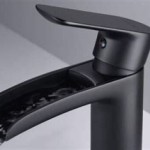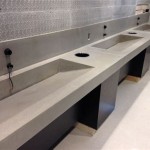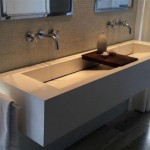Best Bathroom Sinks: A Comprehensive Review
Selecting the right bathroom sink is a crucial decision when designing or renovating a bathroom. It's not simply about aesthetics; the sink must also be functional, durable, and appropriate for the available space. This review examines various types of bathroom sinks, assessing their strengths and weaknesses to assist in making an informed purchase.
The modern bathroom sink market offers a diverse range of styles, materials, and installation methods. From classic pedestal sinks to sleek vessel sinks, understanding the nuances of each option is paramount. This article will delve into the key factors to consider when choosing a bathroom sink, providing insights into the top contenders in the current market.
Understanding Different Types of Bathroom Sinks
Bathroom sinks are categorized primarily by their mounting style. Each type offers a distinct aesthetic and set of practical considerations. Exploring these different types is essential for determining the best fit for a specific bathroom layout and design preferences.
Pedestal Sinks: These sinks consist of a basin supported by a freestanding pedestal. They are a classic choice, often favored for their space-saving design and elegant appearance. Pedestal sinks are particularly well-suited for smaller bathrooms or powder rooms where storage space is not a primary concern. A significant disadvantage is the lack of built-in storage, potentially requiring additional bathroom furniture for toiletries and other essentials.
Wall-Mounted Sinks: As the name suggests, wall-mounted sinks are directly attached to the wall, leaving the floor space underneath open. This creates a sense of spaciousness, making them ideal for smaller bathrooms. Wall-mounted sinks offer flexibility in terms of mounting height, allowing for customization to accommodate users of different heights or those with mobility concerns. However, the installation process can be more complex, requiring reinforcement of the wall to support the weight of the sink and plumbing. Furthermore, like pedestal sinks, they typically lack integrated storage.
Vessel Sinks: Vessel sinks, also known as above-counter sinks, sit on top of the bathroom countertop. They are a statement piece, adding a touch of contemporary style to any bathroom. Vessel sinks come in a wide variety of shapes, sizes, and materials, allowing for significant design customization. The height of the countertop needs to be carefully considered to ensure comfortable use, as the overall height of the sink will be greater than other types. Cleaning around the base of the vessel sink where it meets the countertop can sometimes be challenging.
Undermount Sinks: Undermount sinks are installed below the countertop, creating a seamless and clean look. This design simplifies cleaning, as there is no raised rim to trap dirt or debris. Undermount sinks typically require a solid surface countertop, such as granite or quartz, as the edge of the countertop is exposed. They offer a modern and understated aesthetic and are a practical choice for busy bathrooms.
Drop-In Sinks: Also known as self-rimming sinks, drop-in sinks are installed by dropping them into a pre-cut hole in the countertop. The rim of the sink rests on the countertop, providing support. Drop-in sinks are relatively easy to install, making them a popular choice for DIY renovations. They are available in a range of materials and styles, offering versatility for different bathroom designs. However, the rim of the sink can sometimes trap dirt and require more frequent cleaning.
Console Sinks: Console sinks combine the elegance of a pedestal sink with the added benefit of some storage space. They typically feature a sink basin supported by legs, with a shelf or two underneath for storing towels or other bathroom essentials. Console sinks offer a classic and stylish look and provide a practical solution for bathrooms where storage is limited. They are often a good compromise between a pedestal sink and a vanity.
Vanity Sinks: Vanity sinks are integrated into a bathroom vanity, which provides both storage and countertop space. They are the most common type of bathroom sink, offering a practical and functional solution for any bathroom. Vanity sinks come in a wide range of styles, sizes, and materials, allowing for endless design possibilities. Choosing the right vanity sink involves considering the size of the bathroom, the storage needs of the user, and the overall aesthetic of the space.
Material Matters: Exploring Construction Materials
The material of a bathroom sink significantly impacts its durability, appearance, and maintenance requirements. Selecting the right material is crucial for ensuring the sink meets the specific needs of the bathroom and the user.
Porcelain: Porcelain is a popular choice for bathroom sinks due to its durability, affordability, and ease of cleaning. It is a non-porous material, making it resistant to stains and bacteria. Porcelain sinks are available in a wide range of colors and styles, offering versatility for different bathroom designs. However, porcelain can be prone to chipping or cracking if subjected to impact.
Vitreous China: Vitreous china is a type of porcelain that has been fired at a higher temperature, making it even more durable and resistant to stains and scratches. It is a common material for bathroom sinks and toilets alike. Vitreous china sinks offer a smooth, glossy surface that is easy to clean and maintain. While more durable than standard porcelain, it is still susceptible to damage from impact.
Ceramic: Ceramic is a broad term that encompasses both porcelain and vitreous china. Ceramic sinks are generally durable and affordable, making them a popular choice for bathrooms. They are available in a variety of colors, styles, and finishes. The specific durability and maintenance requirements of a ceramic sink will depend on the type of ceramic used.
Stone: Stone sinks, such as granite, marble, and travertine, offer a luxurious and natural aesthetic to any bathroom. They are durable and unique, with natural variations in color and pattern. Stone sinks require regular sealing to protect them from stains and water damage. They are also typically more expensive than other types of bathroom sinks.
Glass: Glass sinks offer a modern and elegant look. They are available in a variety of colors, shapes, and textures. Glass sinks are non-porous and easy to clean, but they can be susceptible to scratches and chips. Tempered glass is recommended for bathroom sinks due to its increased durability.
Stainless Steel: Stainless steel sinks are a durable and practical choice for modern bathrooms. They are resistant to stains, rust, and corrosion. Stainless steel sinks are easy to clean and maintain, making them a good option for high-traffic bathrooms. However, they can be prone to scratches and water spots.
Cast Iron: Cast iron sinks are incredibly durable and resistant to chipping and scratching. They are coated with enamel, which provides a smooth and glossy finish. Cast iron sinks are heavy and require strong support for installation. They are a classic choice for bathrooms and kitchens, offering both durability and style.
Key Considerations Before Purchasing
Before finalizing the purchase of a bathroom sink, several factors warrant careful consideration. These factors will influence the long-term satisfaction with the chosen sink and its overall suitability for the intended bathroom.
Size and Space: The size of the bathroom is a primary consideration. In smaller bathrooms, space-saving options like pedestal or wall-mounted sinks may be the most practical. Larger bathrooms can accommodate larger vanity sinks or even double sinks. Measuring the available space accurately is crucial to ensure the chosen sink fits comfortably and does not overwhelm the room.
Style and Design: The style of the bathroom sink should complement the overall design of the bathroom. Consider the existing fixtures, such as the toilet, bathtub, and faucets, and choose a sink that blends seamlessly with the overall aesthetic. The material, shape, and finish of the sink all contribute to its overall style.
Storage Needs: Evaluate the storage needs of the user. If storage is a priority, a vanity sink with ample cabinet space may be the best option. If storage is not a major concern, a pedestal or wall-mounted sink may be sufficient. Consider the types of items that need to be stored in the bathroom and choose a sink that provides adequate storage space.
Faucet Compatibility: Ensure the chosen sink is compatible with the desired faucet. Consider the number of faucet holes in the sink and choose a faucet that matches. The style of the faucet should also complement the style of the sink. Some sinks are designed to be used with specific types of faucets, so it is important to check the manufacturer's recommendations.
Budget Considerations: Bathroom sinks range in price from affordable to luxurious. Establish a budget before starting the search and stick to it. Consider the long-term cost of ownership, including maintenance and potential repairs. While it may be tempting to opt for the cheapest option, investing in a higher-quality sink can often save money in the long run.
Installation Requirements: Consider the installation requirements of the chosen sink. Some sinks, such as drop-in sinks, are relatively easy to install, while others, such as wall-mounted sinks, may require professional installation. Factor in the cost of installation when budgeting for the project.
Accessibility: If the bathroom is intended for use by individuals with mobility concerns, consider the accessibility of the sink. Wall-mounted sinks can be installed at a height that is comfortable for users in wheelchairs. Ensure there is adequate space around the sink for maneuverability.
Maintenance: Consider the maintenance requirements of the chosen sink material. Some materials, such as stone, require regular sealing, while others, such as porcelain, are relatively easy to clean. Choose a material that is easy to maintain and will withstand the daily wear and tear of bathroom use.
Ultimately, the best bathroom sink is the one that meets the specific needs and preferences of the user. By carefully considering the factors outlined above, it is possible to choose a sink that is both functional and aesthetically pleasing, enhancing the overall bathroom experience.

10 Best Bathroom Sinks Review The Jerum Post

10 Best Black Bathroom Sinks Review The Jerum Post

9 Best Bathroom Vanity Double Sinks Review The Jerum Post

8 Best Small Bathroom Vanity With Sinks Review The Jerum Post

The Best Bathroom Sinks Of 2024 Review Oola

Bathroom Vanity Styles To Fit Your Space Forbes Home

The Best 19 Small Bathroom Vanities Of 2024

Reviews For Swiss Madison Voltaire 21 In Rectangular Undermount Bathroom Sink Glossy White Pg 1 The Home Depot

10 Best Single Handle Faucets Review The Jerum Post
:strip_icc()/102130266-3174ac7d31314c7abfc80a1b65a11dd6.jpg?strip=all)
18 Luxurious Bathroom Countertop Ideas For All Budgets
Related Posts







